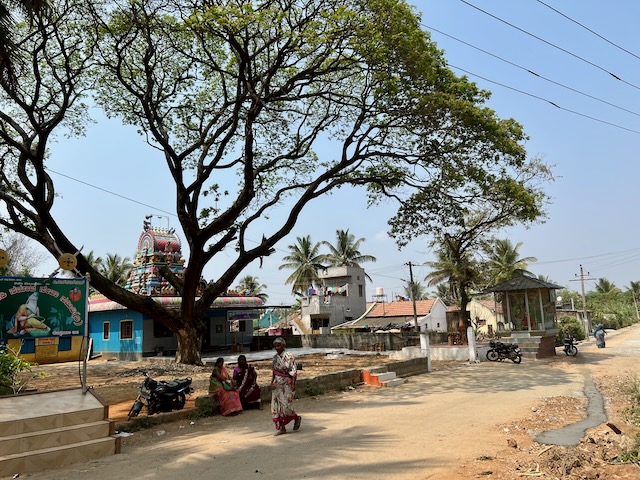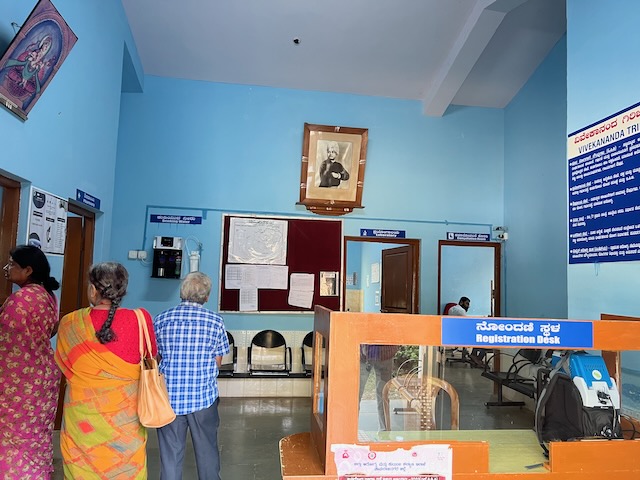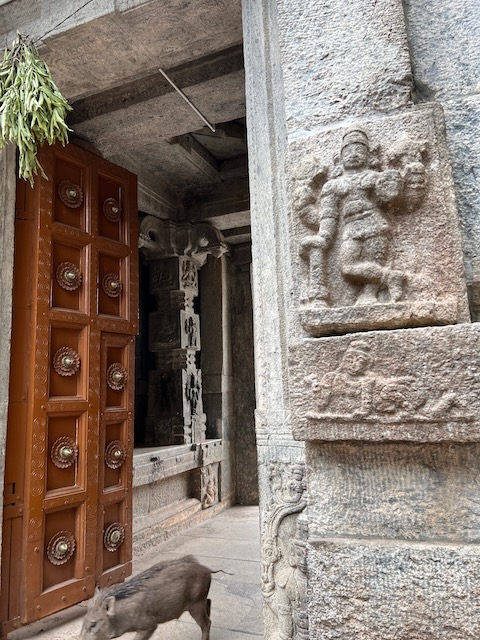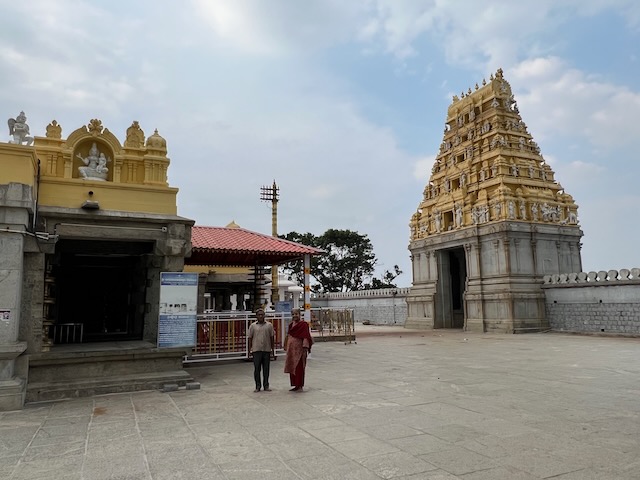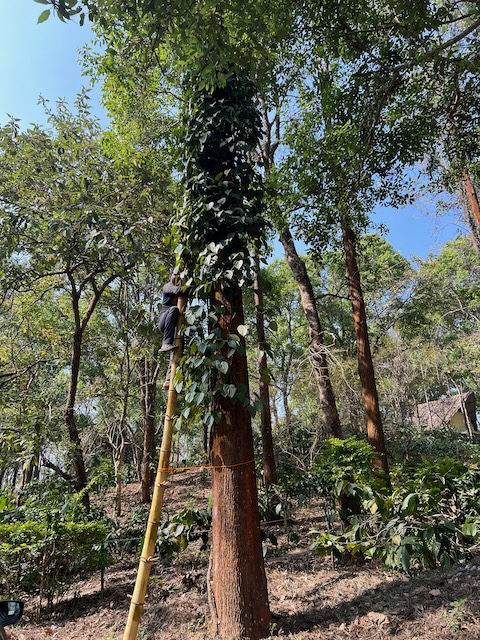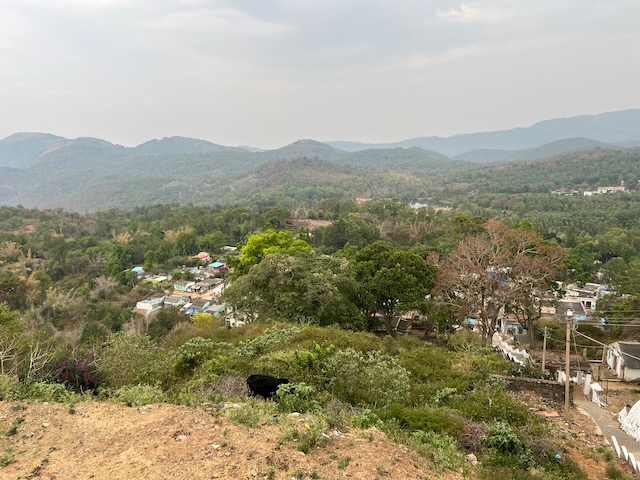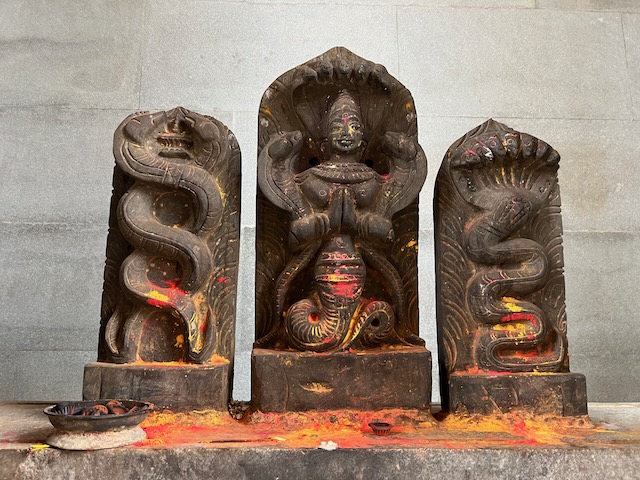I arrive into Bangalore at night and feel like I am coming home when I enter Gayathri’s home. But I have little time to explore the urban changes, as Gayathri, her brother Aravind and I leave the next morning for a tribal eco lodge in the Biligiri Ranganathan Hills about 3 hours South. We drive in Gayathri’s very new car with a hired driver. I have a seat belt in the back.
Driving through rural Karnataka is finding the joy of old memories. There are great expanses of water and hills in the background, the double-yoked oxen in the field and double-yoked oxen pulling carts on the road. In front of one small mud brick homes, goats play under tether shaded by porches from the hot sun. I don’t think I would describe it very differently if I was on this road in 1965. It is essential rural India with the addition of new cars, occasional satellite dishes and people talking on cell phones.
Tall coconut palm trees are everywhere among fields of rice paddies, green vegetables, mulberry bushes for the silk industry and corn. Some homes in the villages we pass have thatched palm roofs, and many have sheet metal which must be stifling in this heat. We pass a covered stall on the road selling large watermelons and another selling sugar cane juice being pressed on the spot. Suddenly in a field a large concrete arch appears with bright colored friezes of many gods and goddesses, seemingly leading to into an empty area but where a temple must lie in the distance.
In the small town we drive through are small food shops and stalls selling the staples of Indian cuisine: tomatoes, coconuts, onions, cucumbers, grapes, melons, potatoes and green beans, each piled high on carts or arranged in pyramids to attract customers. I see women selling bright yellow flower garlands for the temples and small stores for shoes, mattresses and pillows, and then one with plucked hanging chickens. Not everyone here is vegetarian. I see shiny bathroom fixtures being sold next to a paint store, tea and chai stalls, vehicle repair shops and then we are back to the countryside with more men leading oxen and bullocks for work. There are far more motorcycles on this road than cars, and an occasional bus.

We are off the main highway and find ourselves in another small village with road work and a ditch with space wide enough for only a motorcycle to cross. We get out to lighten the load while the two men decide they will try to cross, finding clods of dirt to fill in the hole. Gayathri and I are nervous and want to turn around and find another way around. I find a gravel pile with some hard rock and carry that over and men follow suit so we have at least a few hard rocks for support. There is no one around to help us if we get stuck and we hold our breaths as the driver skillfully manages to make it across. Two other cars suddenly come from the other direction, see what we are doing — and turn around. You never know what you will experience in India.
The resort is wonderful, an NGO funded by a Bangalore doctor to help the local tribal people with training for work, and founding a health clinic and a school as well. We were told by the resident manager here that the local tribal people were only recently introduced to modern life and are quite shy about interacting with outsiders. On a walking tour of the area, we are taken to the clinic and I see an educational billboard, in the local Kannada language, with a photo of sickle cells and learn that this tribe, as well as other tribes throughout India, have been very recently found to suffer from sickle-cell anemia, a serious disease most well known among the African-American community in the U.S. but obviously with a genetic factor that carried over to India. One hypothesis is that the isolated inter-marriage among the tribal people for centuries contributed to a gene pool suffering from this illness.
We and two other families who are there are given a cultural performance at night, with tribal dances and songs around a bonfire. I was quite worried about the sparks carried in the air into dry woods but the locals did not seem concerned.
We go for a guided afternoon walk up 300 steps to a beautiful Chola-era 1000 year old Vishnu temple on a hilltop and I wonder how the heavy granite stones were quarried and carried in this rural area. We find out after our exertion that recently there was a road built up to the foot of the temple and it is a much easier walk back. The original temple is beautiful and many people come for daily puja ceremonies.


We are the only guests the next day and we take a morning bird walk at 7 am with our guide pointing out birds I have never heard of and listening to strong vocal calls in the quiet and cool morning air. Luckily Gayathri is able to translate from Kannada to English for me. In addition to the unmistakable sound of wild peacocks, there were bright golden orioles, red-whiskered bulbuls and oriental white-eyes, among magpies, mynahs, swifts, parakeets and a jungle babbler which we are told are always found in groups of 7. The beauty of a green quiet forest.
On our way back, we stop at the Sri Ravi Shankar’s Art of Life ashram and meditation center. It is a whole small city of devotees, with 3 free meals offered daily to any visitors, and meditation and philosophy classes. It is kept immaculately clean. But elsewhere trash is everywhere on the streets of modern India, both plastic and paper refuse scattered around every vacant lot and the edges of roads. There are no waste bins on the streets and seemingly no trash collection here. When I asked my friend what happens with her home garbage she replies that her cleaning person gathers it all up daily and takes it somewhere unknown. I can only imagine.
We return to the chaos of Bangalore and a very different environment.



